 |
| |
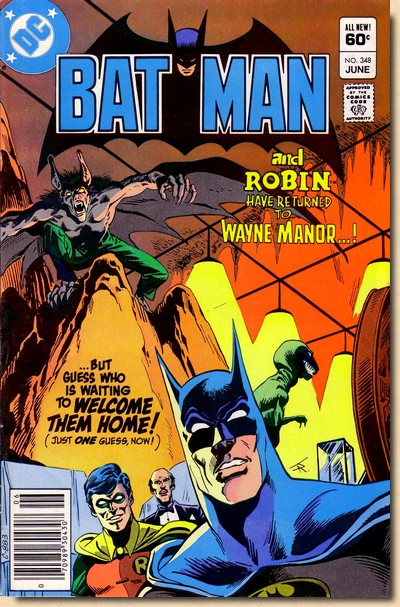 |
|
BATMAN
#348
(JUNE
1982)
BATMAN
RETURNS TO
THE BATCAVE
GERRY
CONWAY HAS THE KEYS
"Shadow
Play"
(18 pages)
Cover
pencils - Jim Aparo
Cover inks - Jim Aparo
Cover colouring - Anthony Tollin
Story - Gerry
Conway
Art - Gene Colan
Inks - Klaus Jansen
Colours - Adrienne Roy
Lettering - Ben Oda
Editor - Dick Giordano
Second
feature - Catwoman, "The Man, the
Bullet, the Cat (Part 1)" (7 pages)
Letters page - "Batsignals" (1
page)
|
|
|
| |
"MOVING
DAY AT WAYNE MANOR: IN THE MANSION
ABOVE, OLD FAMILIAR ROOMS HAVE BEEN DUSTED,
WINDOWS OPENED, RUGS BEATEN AND
DRAPERIES CLEANED.
BRUCE WAYNE AND DICK
GRAYSON HAVE COME HOME AT LAST...
AND TONIGHT, THEIR ALTER EGOS
HAVE RETURNED TO THE ORIGINAL BATCAVE."

|
|
| |
PLOT
SUMMARY
Following
an announcement made by Bruce Wayne (in the final
panel of Detective Comics #513), the
Dynamic Duo and Alfred are back at Wayne Manor
and touching up the old Batcave back to its
original former glory and functionality.
Just
as they are in the midst of repositioning the
numerous large prize trophies the trio of movers
is called to the front door where they find an
enraged Francine Langstrom who verbally and
physically attacks Bruce Wayne and blames him for
neither helping her and her child nor finding a
cure for her husband Kirk Langstrom's sickness
(i.e. turning into Man-Bat). Overcome by emotions
and fatigue, Francine Langstrom faints after
having accused Bruce of being a rich monster who
cares for nothing and nobody but himself.
Visibly
taken aback, Bruce changes into Batman gear in
the cave and has Robin take Rebecca, the young
Langstrom girl, down into Batcave in spite of
Alfred's and Dick's protest that this may be an
unwise step - but obviously, the accusations made
by Francine Langstrom (who is resting in a room
of the Manor) weigh heavily on the Batman's
conscience.
Batman
grabs an antidote - of which he believes that it
will either cure Kirk Langstrom or kill him -
and, after recounting to Robin and Alfred the
facts of how exactly Kirk Langstrom came to be
the Man-Bat (back in Detective Comics
#400, June 1970) - sets out to find Langstrom,
taking Rebecca with him as he feels that this
might actually help save her father.
As fate and
happenstance would have it, the Batman need not
look far as the Man-Bat has actually made the
vacated Batcave his abode and hiding place...
|
|
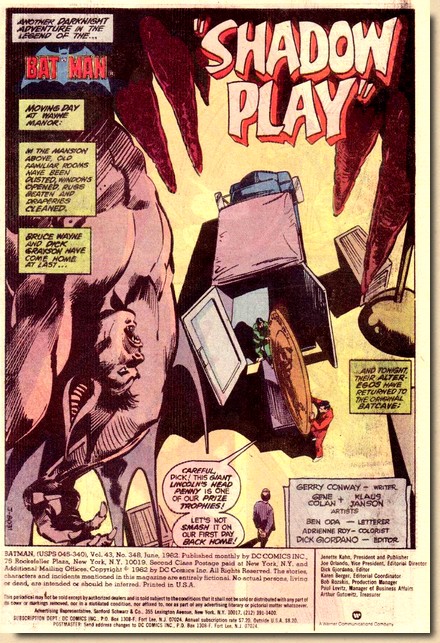 |
|
| |
| Elsewhere, former Police
Commissioner James Gordon spends the night gazing from a
bridge into the Gotham River until his daughter Barbara
stops by and tells him to finally come home. The word
rings somewhat out of tune for Gordon, who muses that he
lost his home when his wife died and that for many years
since Police HQ had been his home - but now, he feels, he
no longer has any home at all. Barbara Gordon dislikes
the way her father behaves like an old lost man, and
decides to try and get him back into working order whilst
ponderingly looking at the calling card of one Jason
Bard, investigator... And
yet in another location that very same night, Vicki Vale
informs Morton Deal, the editor of Picture News, that she
has photographic proof of Batman's true identity but that
she will not hand over the pictures for publication yet
because she wants to be 100% sure about her facts - after
all the incidents which took place the last time someone
had claimed to be in possession of precisely that
information (i.e. Arthur Reeves losing the mayoral
election - back in Batman #344). She asks Deal
to have a little more patience, but as soon as Vicki has
left he picks up the phone and relates the information he
has just received to "Boss" Thorne, who is
precisely the person behind the manipulation of the
mayoral election...
|
| |
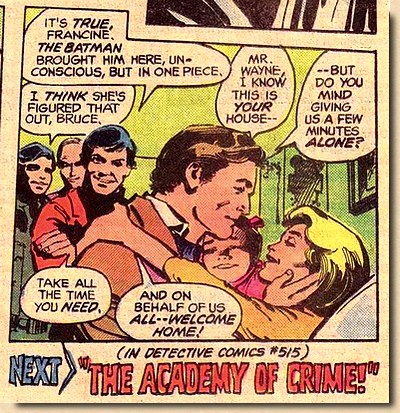 |
|
Meanwhile,
back in the Batcave, Batman and Man-Bat finally
hit upon each other, but Langstrom manages to
push the Darknight Detective over an edge inside
the cave, and whilst Batman can grab hold of an
outcrop and pull himself back up again, he finds
that Man-Bat has taken Rebecca with him. Advancing ever further into
the depths of the Batcave, Batman finally catches
up with Man-Bat and, in front of a terrified
child, the two opposing personifications of the
Bat battle it out with each other, but Langstrom
- who despite his state of being the Man-Bat
recognizes his daughter - once again grabs
Rebecca and takes her up to precarious heights
inside the giant caves underneath Wayne Manor.
However, the Batman has made use of Man-Bat's
focus being on the child, and comes up from
behind, jabbing an injection with the antidote
into Langstrom's neck... and fate is in a kind
mood this night, for the antidote works and
transforms Man-Bat back to his actual self, Kirk
Langstrom.
And so, the move
back into the Batcave has proven a turbulent
affair, but at least all's well that ends well...
and the next adventure awaits in the
pages of Detective Comics #515 ...
|
|
| |
REVIEW & ANALYSIS
Following a
brief interruption for the May 1982 cover date production
run with completely non-interconnected single issue
stories in Detective Comics
#514
by Len Wein and Batman #347 by Roger Slifer,
Gerry Conway was back at the wheel to kick off the second
wave of crossovers between the Batman and Detective
Comics titles. Still evaluating reader reactions (as
Dick Giordano's question in that direction ("Would
you rather we drop all continuing threads?"),
put forward to readers in the letters page of Batman
#350, clearly showed) DC opted for a subtle and low-level
re-entry into the crossover formula by having Batman
#347 feature a basically self-contained one issue story
but set into the background of a continuing plot running
over from Detective Comics and then feeding back
into that same title.
And again -
just as he would do with the vampire story arc, starting the next
issue of Batman - Conway delivers proof that he
is indeed a master of the subplot whilst at the same time
keeping an interesting story moving up front. This time
around, he makes good use of the return of the Dynamic
Duo to the original Batcave - a move greeted with
enthusiastic approval by the readers - by slipping Batman
an opponent who is virtually a natural to those cavernous
surroundings: Man-Bat. At the same time, Conway also
moves a number of subplots along, setting up James
Gordon, Vicki Vale and "Boss" Thorne for
further storylines, which even hint at a possible
unmasking of the Batman by his new romantic interest.
|
| |
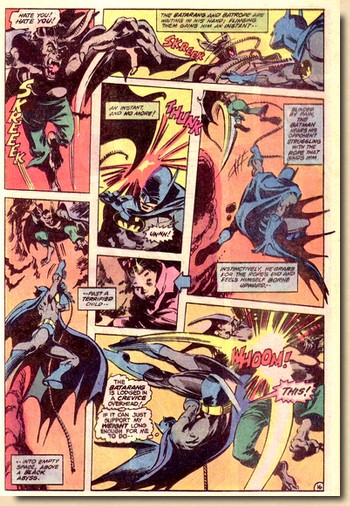 |
|
It all falls together very
well, even if some elements of the main story may
be somewhat on the melodramatic side. But then
again, Conway provides characterization (even
fitting in a one page recap of Man-Bat's origin),
and drama is all a part of it when it comes to
the world of Batman. Just as vivid
and entertaining as Conway's plotting is Gene
Colan's artwork, which is so dramatic and indeed
cinematographic that it almost seems to pop out
at the reader in 3D in places. Colan provides
first class pencils throughout this issue, but
the fight scenes are especially worth pointing
out, where "the Dean" is in complete
command and uses highly dynamic and
unconventional panel layouts to further enhance
the flow of his artistic style, whilst the inks
by Klaus Janson go along well and preserve the
weight for which Colan's pencilling was famous.
The
end result is a comic book which meshes content
and visuals to near perfection, embellished
further by Adrienne Roy's colouring which just
sits right.

Highly
RECOMMENDED
READING -
Another well executed example by Gerry Conway of
how interestingly a storyline with multiple
subplot threads can be told in just one issue,
crowned with all the atmospheric and cineastic
artwork for which Gene Colan is renowned.
|
|
| |
BAT-MAN
VS. MAN-BAT
Created by Frank
Robbins and Neal Adams for Detective Comics
#400 (June 1970), Man-Bat is actually Dr. Kirk
Langstrom, a scientist who was studying bats in
the hopes of mimicking their sonar abilities to
allow the blind to see. Creating an experimental
serum derived from bat glands, Langstrom tries
out the formula on himself but finds that
transforms him into a "Man-Bat",
complete with sonar and enormous and functional
leathery wings.
In later
appearances, Man-Bat learned to control his
monstrous form, and even embarked on a
short-lived career as a superhero-for-hire in his
own comic-book series in 1975 - which however
only lasted for two issues.
In the "New
52" version of the DC Universe most of Kirk
Langstrom and Man-Bat's origin and background
story of the serum has been altered
substantially.
Seen mostly as a
"classic" Batman villain, this
appreciation no doubt stems from the fact that
his visuals were created by Neal Adams, the
archetypal pop culture icon Batman artists, and
that the concept elaborated by equally famed
Frank Robbins presents Batman almost with his
personal antithesis: whereas Bruce Wayne is
always still a man (albeit one who assumes
certain qualities of a bat), Man-Bat is a
creature who tries to block out any remnants of
its human origin - and often almsot succeeds. In
this respect, Man-Bat is also a parable for the
fact that good and bad often coexist very
closely.
|
|
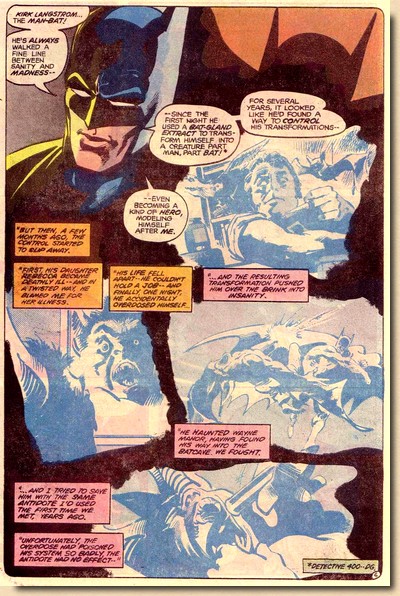 |
|
| |
| Gerry Conway was revisiting
many such classic Batman villains during his run in the
early 1980s, but not wanting to take any chances with new
readers (who might well have no previous knowledge of the
Batman Universe), he would always slip in an origin recap
which also gave readers a quick rundown on the essentials
of a villainous character. Sometimes a panel would be
enough, but in the case of Man-Bat a whole page was
required to work out the fine balance between good and
evil in conjunction with Man-Bat. |
| |
TO THE BATCAVE !
Batman #348 also
heralds the return of the Dynamic Duo to Wayne Manor and
hence also to the original Batcave underneath the Wayne
family's historic stately home. Bruce and Alfred had left
for good when Robin left in order to attend Hudson
University, and moved to the Wayne Foundation building in
central Gotham City (all in Batman #217 from
December 1969).
|
| |
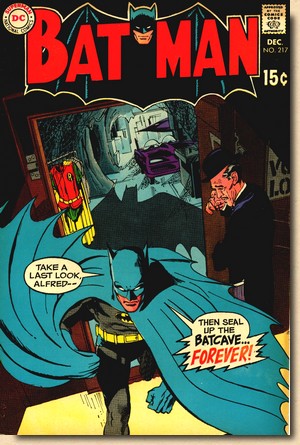 |
|
It was, literally, a drastic
move by comic book standards. After all, the
Batcave had become a set piece in the perception
of Batman as a popular culture icon, not the
least cemented into place by the frequent views
offered to the millions of people watching the
1960s cult television series - and the trademark
call of "Robin, to the Batcave!" But then
maybe that was precisley what writer Frank
Robbins had in mind at the time.
"Batmania" was over for good, and by
the end of the 1960s a number of talents at DC
comics had to almost reinvent the Darknight
Detective from scratch in order to pull the
character from the debris of the "camp"
era when the comic books followed the TV series
as closely as they could in order to cash in on
the popularity (which they did, at least for a
while). When the TV show ended, so did the good
times for the Dynamic Duo in their original
medium.
From
this perspective, leaving the Batcave and
"sealing it up forever" (as shown on
the iconic Neal Adams cover) in order to move to
more modern premises could also be seen as
slightly symbolic.
In
any case, readers were to find out that unlike
with many other "teaser covers" (where
events which loomed would ultimately not unfold)
the closing up of the Batcave was for real - it
would not be opened up again until Gerry Conway
handed Bruce Wayne and Alfred (and Dick) back the
keys in Batman #348. Which made for an
incredible 131 issues (and twelve and a half
years in real time) without the original Batcave.
|
|
| |
| Before being closed down
and sealed, the Batcave had existed for a good 26 years.
As a concept, it had gradually evolved from a
"secret tunnel" between Wayne Manor and a
"dusty old barn" to something more elaborate as
the Batman obviously needed some place to store his
growing arsenal of machinery. |
| |
| In Batman
#12 (August 1942) Bill Finger had the Dynamic Duo
descend by elevator into "the Batman's
secret underground hangars". When the more
or less unaltered cut-away schematic illustrating
this concept was reused for the Batman
daily syndicated newspaper strip for 29 October
1943, it was labelled "Bat Cave". However, neither Bill Finger
nor Bob Kane had come up with that idea - it was
the brainchild of Victor McLeod and Leslie
Swabacker.
Screenwriting the
1943 Columbia serial Batman, McLeod and Swabacker
came up with the idea of calling the Caped
Crusader's underground crime lab "bat
cave"; the second of the total 15 episodes
is even entitled "The Bat's Cave".
Legend has it that
Bob Kane, on returning from the studio set, told
Bill Finger to take up that idea for the daily
Batman newspaper strip.
The Batcave finally
made its comic book debut proper in Detective
Comics #83 (January 1944). Over time, it
expanded (although subsequent writers cared
little about consistency) to include not only a
Batcomputer and a state of the art forensic lab
but also a number of trophies.
The most iconic and
consistently featured trophies are a full-size
animatronic Tyrannosaurus Rex (which comes from
an adventure on "Dinosaur Island" in Batman
#35 from 1946), a giant replica of a Lincoln
penny (originally a trophy from Batman's
encounter with a penny-obsessed villain named the
Penny Plunderer in World's Finest Comics
#30 from 1947, but later retconned as stemming
from an encounter with Two-Face - and prominently
featured on the splash page of this issue of Batman),
as well as an oversized Joker playing card (with
obvious origins).
|
|
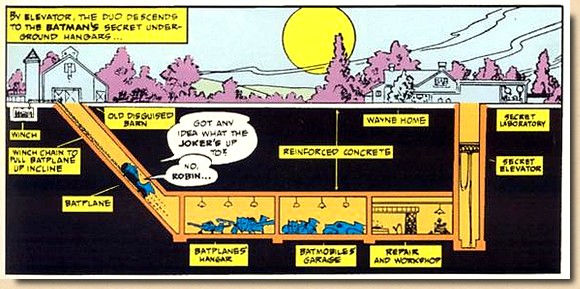
Batman
#12 (August 1942)
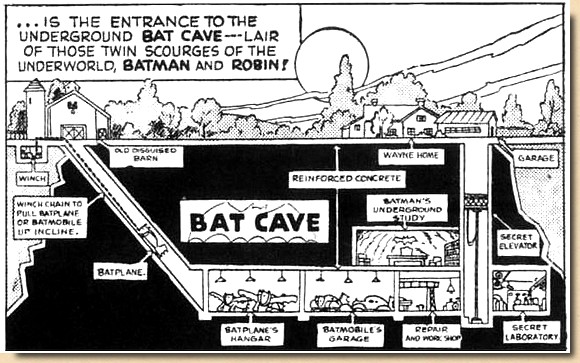
Batman
Daily Newspaper Strip (29 October 1943)
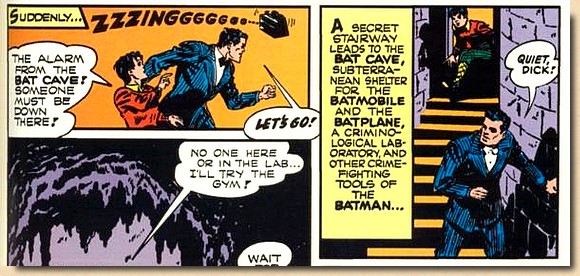
Detective
Comics #83 (January 1944)
|
|
| |
FACTS & FIGURES
Batman
#348 initiates
the second wave of the 1982 crossovers between Detective
Comics and Batman. It was
sold in two variant version: a newsstand edition (with a
barcode on the cover) and a direct market edition (with
the barcode area left blank and displaying the DC logo
plus the blurb "WHERE THE ACTION IS")
which also carried a UK price of 20p.
|
| |
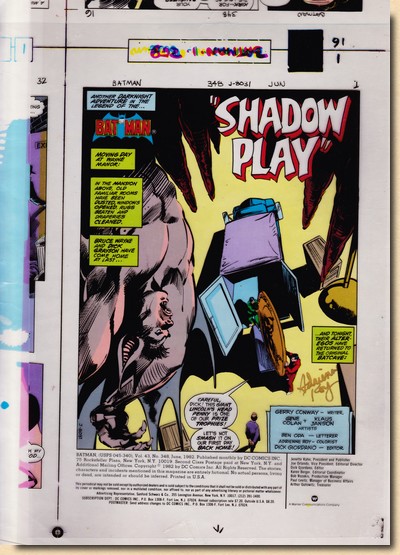 |
|
"Shadow Play" was
reprinted in Batman in the Eighties
(2004) and is collected in Gene Colan - Tales
of the Batman Vol 1 (2011). "Shadow
Play" was almost instantly translated and
reprinted for the European market in 1982 - Ehapa
published a German version (although somewhat
drastically shortened by four pages) in Batman
Sonderheft #27, and Semic AS put out a
Norwegian version in Superserien #24.
The original
artwork for the splash page
shows that inker Klaus Janson was erroneously
lettered as "Jansen" by Ben Oda,
prompting Janson to ink in the remark "DICK
- CORRECT "JANSON" - TEN YEARS
IN THE BUSINESS AND I GET AN "E" -
SHEEESH !!" The original art for
the splash page also reveals another trick of the
trade as Gene Colan requested "DICK
- PLEASE STAT DOWN FIGURES OF BRUCE, DICK +
ALFRED RELATIVE TO "PENNY".
The printed artwork does indeed show the three
figures to have been downsized.
The four Rubylith® acetate colour separation
overlays (one each for the "subtractive
primary colours" cyan, magenta and yellow
plus the black "key" - hence CMYK) for
the splash page have survived (autographed by
colourist Adrienne Roy), and they show a fact of
the printing process which is often forgotten -
namely that four comic book pages were printed
one one sheet of paper and then cut and folded.
In this case, pages 1 (the splash page) and 32
werde side by side on one row and pages 16 and 17
on another. This print grid would get pages 2 and
31 plus 15 and 18 printed on its reverse side.
|
|
| |

|
| |
| BIBLIOGRAPHY CRONIN Brian (2010)
"Comic Book Legends
Revealed #279", Comic Book Ressources
|
| |
|














